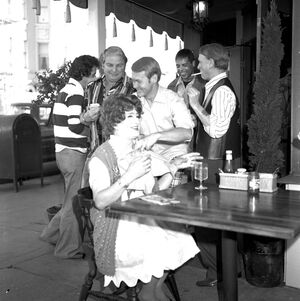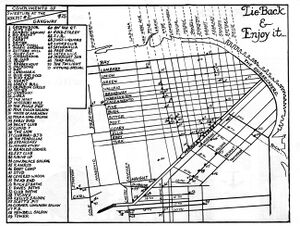Difference between revisions of "Blue-collar Heterosexual Taverns and Restaurants “Turn Gay”"
(New page: Polk Street, well known as a “cruisy” gay male corridor and bordered by middle-class gay male rooming houses, was poised to serve as this space. Bars, taverns, and bathhouses also popu...) |
m (Protected "Blue-collar Heterosexual Taverns and Restaurants “Turn Gay”" [edit=sysop:move=sysop]) |
||
| (7 intermediate revisions by one other user not shown) | |||
| Line 1: | Line 1: | ||
| + | Text by Joey Plaster. Copyright (©) by C. Joey Plaster, 2009. All rights reserved. | ||
| + | |||
| + | |||
| + | [[Image:QTbar.jpg|thumb|Birthday party at "On the Q.T." Courtesy of the GLBTHS. ]] | ||
Polk Street, well known as a “cruisy” gay male corridor and bordered by middle-class gay male rooming houses, was poised to serve as this space. Bars, taverns, and bathhouses also populated the area: the primary pre-gay liberation meeting places for gay men. As San Francisco’s white, blue-collar population shrank, so did the clientele for Polk Street’s taverns and drinking establishments. In a process that would repeat in the following decades, they now one by one “turned gay” to cash in on the gay market. | Polk Street, well known as a “cruisy” gay male corridor and bordered by middle-class gay male rooming houses, was poised to serve as this space. Bars, taverns, and bathhouses also populated the area: the primary pre-gay liberation meeting places for gay men. As San Francisco’s white, blue-collar population shrank, so did the clientele for Polk Street’s taverns and drinking establishments. In a process that would repeat in the following decades, they now one by one “turned gay” to cash in on the gay market. | ||
| − | |||
| − | In an indication that the transition was accompanied by some conflict, in 1962 the Polk Street Merchant’s Association discussed the “problem of social variants in the Polk Street Area.” The association president explained to LCE editor Guy Strait that “mothers, the PTA and others were always calling him and objecting to some of the variants in the neighborhood.” Strait responded, “if they don’t want the business of the social variant, all they need to do is to put a sign in their window to that effect and they will not then be at all bothered with it.” | + | “The owners [of Polk Street’s Cloud Seven] confessed they weren’t making any money,” recalled bartender Greta Grass. So in 1962, “they turned it into a queer bar…and when the owner opened it up as such he ended up doing four times the business without the headaches.”<ref>“Once upon a time in San Francisco,” Bay Area Reporter, 4 April 1996. </ref> Other bars also switched in the early 1960s. The “Rancho” bar became the Su-Z-Q Club in 1960. The 1963 L.C.E. “Roving Report” noted that the perfect “After Aquatic [Park] Spot” was the Jumpin’ Frog, which also opened in 1960.<ref> LCE News, April 1, 1963. </ref> |
| + | |||
| + | |||
| + | [[Image:Sweetlips.jpg|thumb|left|Map of gay bars, c. 1970s]] In an indication that the transition was accompanied by some conflict, in 1962 the Polk Street Merchant’s Association discussed the “problem of social variants in the Polk Street Area.” The association president explained to LCE editor Guy Strait that “mothers, the PTA and others were always calling him and objecting to some of the variants in the neighborhood.” Strait responded, “if they don’t want the business of the social variant, all they need to do is to put a sign in their window to that effect and they will not then be at all bothered with it.”<ref> LCE News, Nov. 12 1962. </ref> | ||
| + | |||
| + | |||
| + | Profit appears to have trumped prejudice; the switch to a gay market had become commonplace on Polk Street by the late 1960s. “Like too many places that allow this route,” the Bay Gourmet reported about “On the Q.T.,” a Polk Street restaurant that had “turned” gay in 1970, “it was all too obvious why the policy change was made: The place wasn’t making it as a straight restaurant, and the ownership wanted to cash in on the large gay market.”<ref> The Bay Gourmet, date unknown, L. James Beales collection at GLBTHS. </ref> Similarly, in 1969 the French restaurant Alouette became the P.S., a focal point for a thriving gay community. | ||
| + | |||
| + | |||
| + | |||
| + | <references/> | ||
| + | |||
| + | |||
| + | {{Protected}} | ||
| + | |||
| + | |||
| + | [[Category: Commerce]] | ||
| + | [[Category:Polk Street]] | ||
| + | [[Category: 20th century]] | ||
| + | |||
| − | + | <div style="text-align: right; direction: ltr; margin-left: 1em;">• Go to [[The_Tavern_Guild_and_Imperial_Court | Next Article]]</div> | |
Latest revision as of 10:21, 8 May 2009
Text by Joey Plaster. Copyright (©) by C. Joey Plaster, 2009. All rights reserved.
Polk Street, well known as a “cruisy” gay male corridor and bordered by middle-class gay male rooming houses, was poised to serve as this space. Bars, taverns, and bathhouses also populated the area: the primary pre-gay liberation meeting places for gay men. As San Francisco’s white, blue-collar population shrank, so did the clientele for Polk Street’s taverns and drinking establishments. In a process that would repeat in the following decades, they now one by one “turned gay” to cash in on the gay market.
“The owners [of Polk Street’s Cloud Seven] confessed they weren’t making any money,” recalled bartender Greta Grass. So in 1962, “they turned it into a queer bar…and when the owner opened it up as such he ended up doing four times the business without the headaches.”[1] Other bars also switched in the early 1960s. The “Rancho” bar became the Su-Z-Q Club in 1960. The 1963 L.C.E. “Roving Report” noted that the perfect “After Aquatic [Park] Spot” was the Jumpin’ Frog, which also opened in 1960.[2]
In an indication that the transition was accompanied by some conflict, in 1962 the Polk Street Merchant’s Association discussed the “problem of social variants in the Polk Street Area.” The association president explained to LCE editor Guy Strait that “mothers, the PTA and others were always calling him and objecting to some of the variants in the neighborhood.” Strait responded, “if they don’t want the business of the social variant, all they need to do is to put a sign in their window to that effect and they will not then be at all bothered with it.”[3]
Profit appears to have trumped prejudice; the switch to a gay market had become commonplace on Polk Street by the late 1960s. “Like too many places that allow this route,” the Bay Gourmet reported about “On the Q.T.,” a Polk Street restaurant that had “turned” gay in 1970, “it was all too obvious why the policy change was made: The place wasn’t making it as a straight restaurant, and the ownership wanted to cash in on the large gay market.”[4] Similarly, in 1969 the French restaurant Alouette became the P.S., a focal point for a thriving gay community.

